- Home
- Sailing in the Caribbean
- Caribbean Island Hopping
- Caribbean Island Hopping
Caribbean Island Hopping by Sailboat
Part 2: The Windward Islands
The first part of Caribbean Island Hopping saw us sail down through the Leeward Islands from Anguilla to Dominica. Here in Part 2, we continue island hopping south from Martinique to Grenada - the Windward Islands of the Caribbean.
Island Hopping through the Windward Islands of the Caribbean

I don't know exactly how many islands and islets make up the Windward Islands - let's just settle on 'lots'. But I do know that there are just four island nations:
- Martinique;
- St Lucia;
- St Vincent & the Grenadines, comprising St Vincent, Bequia, Mustique, Canouan, Mayreau, Tobago Cays, Petit St Vincent and Union Island;
- Grenada, which includes Carriacou and Petit Martinique.
If the Lesser Antilles (aka the Eastern Caribbean) is one of the most popular sailboat cruising areas in the world, then the Windward Islands must be the jewel in the crown of the Lesser Antilles.
So, with our up-to-date navigational charts and pilot books to hand, and having checked out of Dominica (the southernmost island in the Leeward Island chain) we're heading south towards our next destination - the French island of Martinique.
Martinique
Martinique, the northernmost island in the Windward Islands, is an integral part of the French Republic. Most sailing-related services are available here, and the cruising sailor will not be disappointed by the anchorages along the west coast.
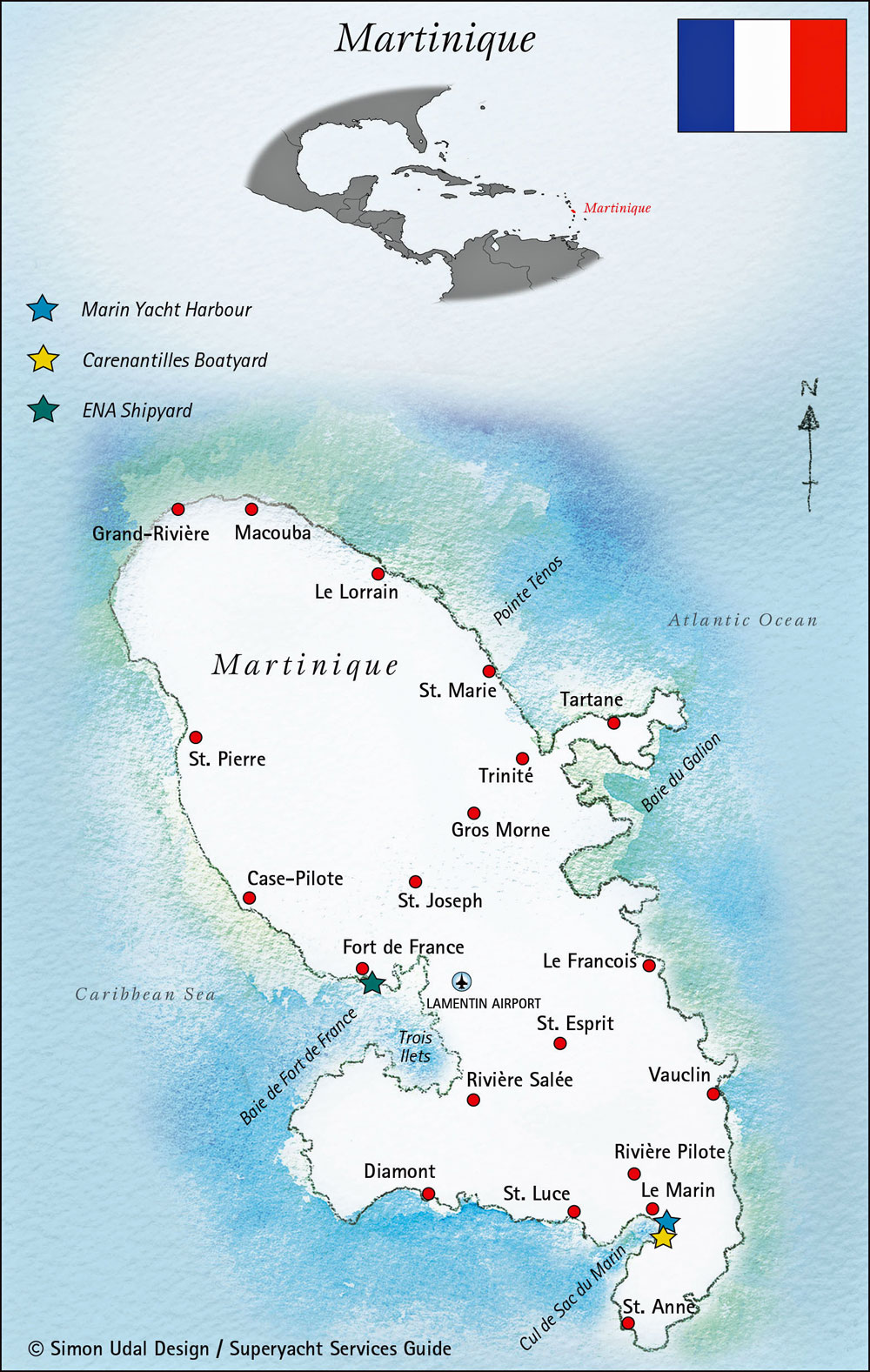
Currency: Euro (€)
Official Language: French
Ports of Entry: St Pierre, Fort de France, Marin, Anse Mitan, Grand Anse d'Arlet and St Anne.
Sailing south from Dominica, the first anchorage you'll come to on the west coast of Martinique is St Pierre, nestling under Mont Pellée, the volcano that caused such tragic carnage when it erupted in 1902.
Today, St Pierre is an active fishing village with some excellent restaurants ashore.
Anchoring here can be tricky as the narrow shelf drops off quickly into depths too deep for anchoring.
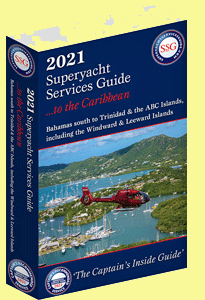
The above map of Martinique, and the other island maps that follow below, are reproduced with the kind permission of their creators 'Superyacht Publications Ltd' and are taken from their super-useful Superyacht Services Guides for the Caribbean in which they make recommendations for all yachting services in each of the islands.
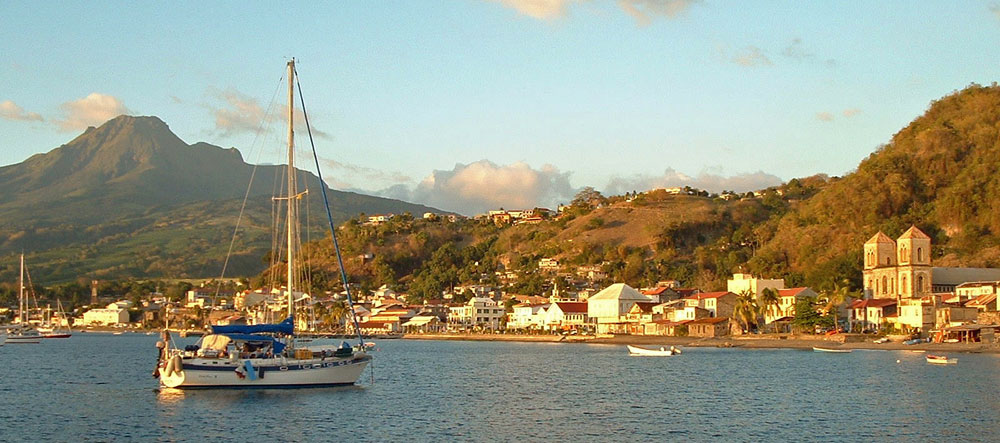 St Pierre, Martinique with Mont Pellée on the left
St Pierre, Martinique with Mont Pellée on the leftMoving south, you can drop the hook off Cas Pilot and Schoelcher, but the next major anchorage is at Fort de France.
In wild weather, or maybe when you're just looking for some peace and quiet, you can find a sheltered anchorage in Les Trois Ilets.
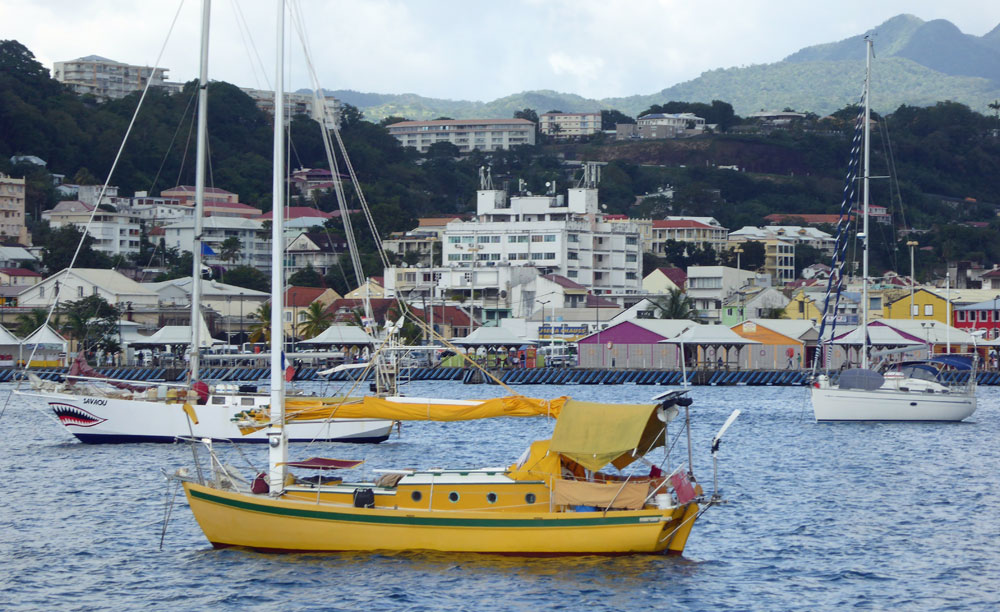 The anchorage at Fort de France, Martinique
The anchorage at Fort de France, MartiniqueLeaving Baie de Fort de France and continuing to head south you'll find several anchorages in quick succession:
- Anse Mitan
- Anse a L'Ane (the birthplace of Josephine, wife of Napolean Bonaparte)
- Anse Noire
- Grande Anse d'Arlet
- Petit Anse d'Arlet
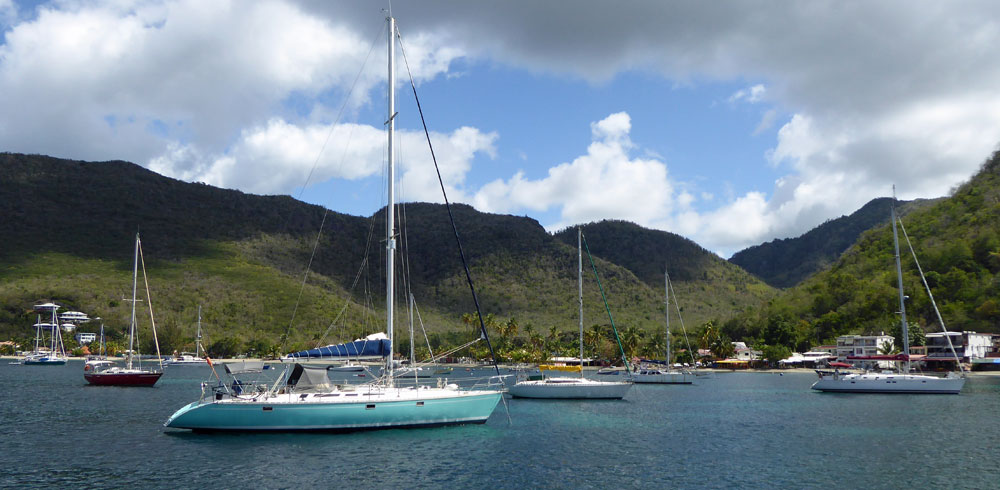 Grande Anse d'Arlet, Martinique
Grande Anse d'Arlet, MartiniqueNext will be the very popular anchorage at St Anne, from where you can find good shelter in the Cul de Sac du Marin if necessary.
Full yacht services including a marina, boatyards and several chandlers can be found in Marin.
You can check out in either Marin or St Anne before enjoying what is usually a fast reach to St Lucia.
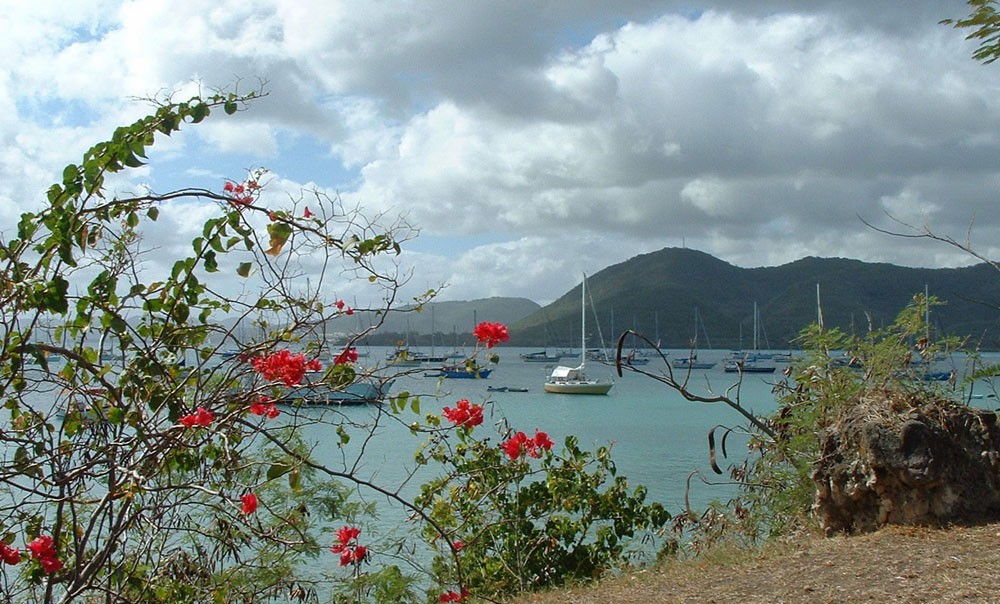 The anchorage at Ste Anne, Martinique
The anchorage at Ste Anne, Martinique
St Lucia
If you arrive at Rodney Bay in mid-December, you're likely to be surprised at the number of boats at anchor in the bay and tied-up in the marina.
Reason? Your arrival coincided with that of the finishers of the ARC (the Atlantic Rally for Cruisers), an annual thinly-disguised race across the Atlantic for sailboats and crews of all kinds.
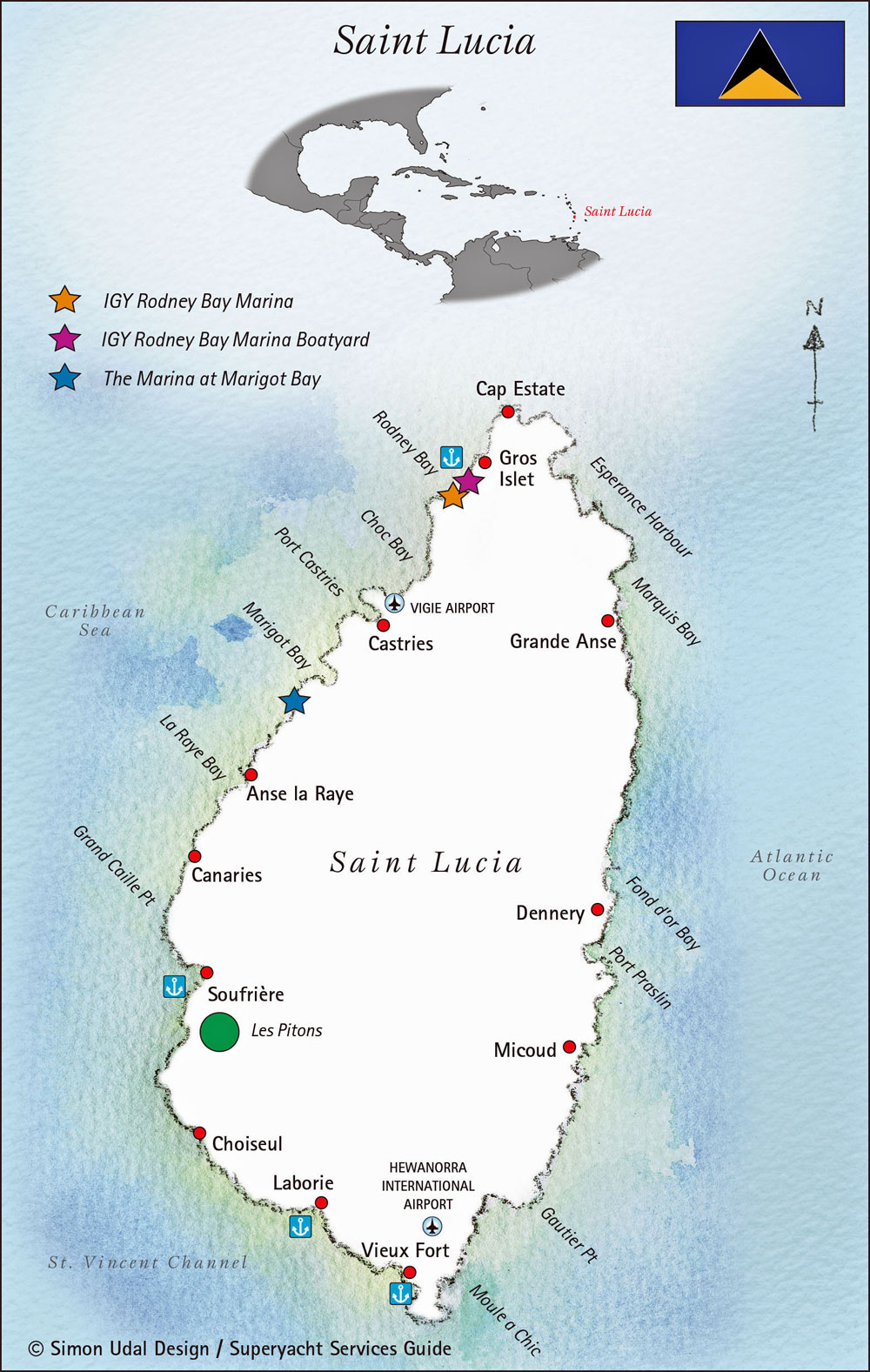
Currency: Eastern Caribbean Dollars (EC$)
Official Language: English
Ports of Entry: Rodney Bay, Castries, Soufriere and Vieux Fort.
Most cruisers choose to drop the hook in Rodney Bay and dinghy ashore to check in with Customs & Immigration in the marina, before heading south to moor or anchor in Marigot Bay.
It was here apparently, that the beach scene involving a giant pink snail in the 1967 film 'Dr Dolittle' was shot.
I'm told that no snails, giant or pink or otherwise, were harmed during the making of the film.
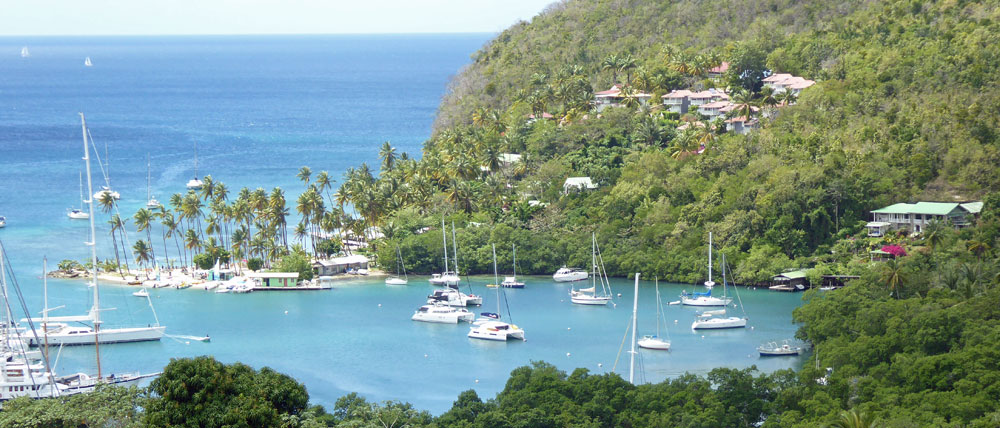 Marigot Bay, St Lucia
Marigot Bay, St LuciaHeading south your eye will be drawn to the magnificent Pitons, two spectacular mountainous volcanic plugs. You can anchor or pick up a mooring in their shadow at Soufriere, an experience not to be missed.
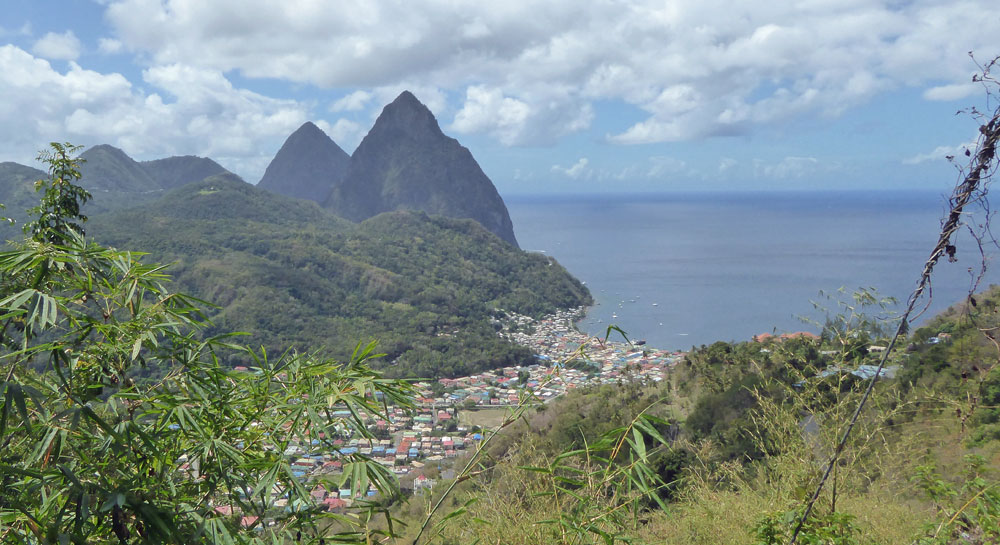 Soufriere and the Pitons
Soufriere and the PitonsYou have the choice of checking out here, or beat to Vieux Fort at the southern tip of the St Lucia to do so.
Next it's St Vincent where, in the acceleration zone off the north of the island, you can expect some lively conditions.
St Vincent
The slopes of the volcano at the northern end of the island used to be taken over by plantations of tobacco-like crops of dubious legality. To be fair, some of this activity was licensed for the newly developing Medical Cannabis Industry.
However, the eruption of the volcano in April 2021 put an end to this, and the ensuing dust cloud caused massive disruption to life on the island.
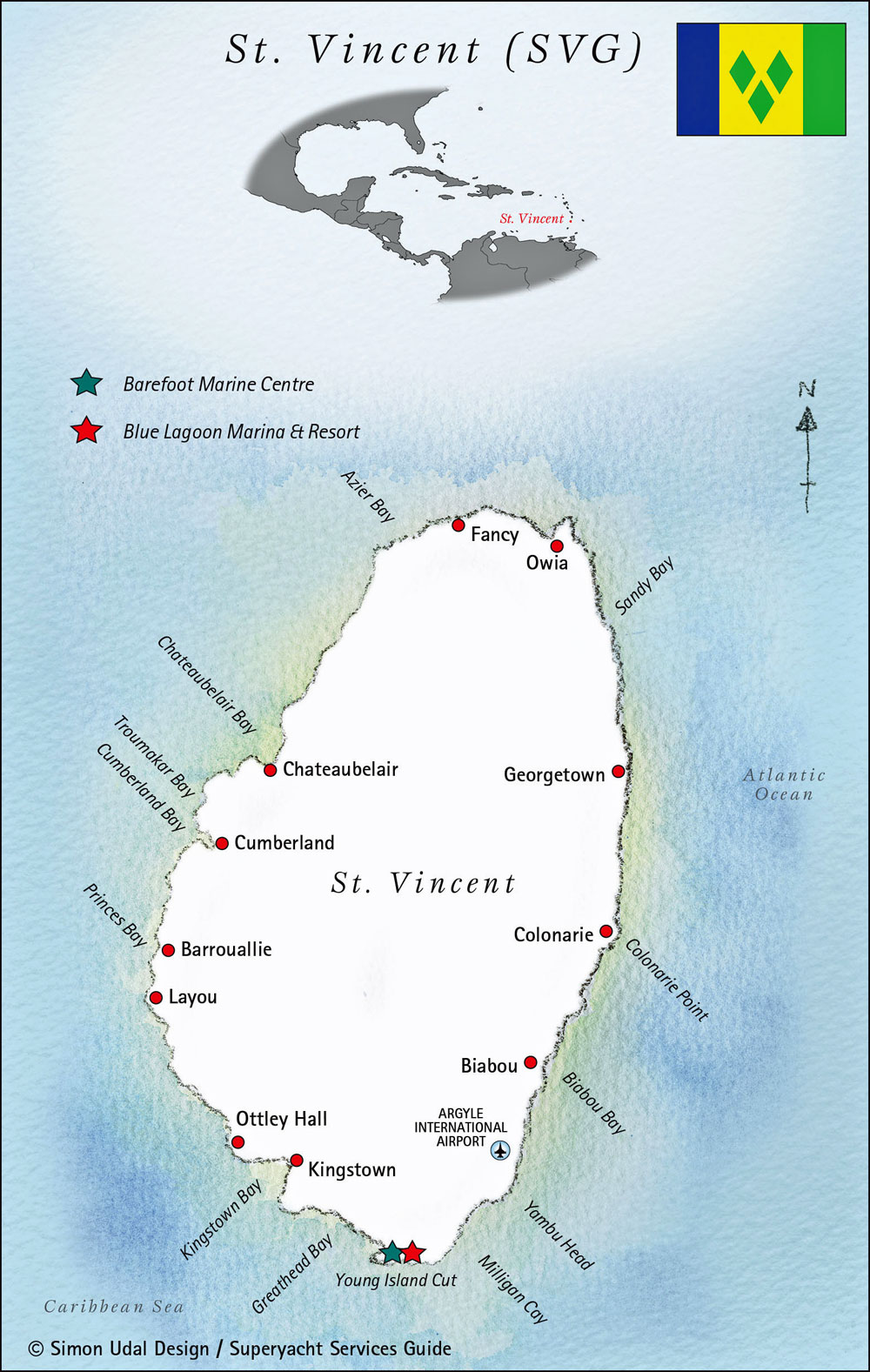
Currency: Eastern Caribbean Dollars (EC$)
Official Language: English
Ports of Entry: Chateaubelair, Wallilabou and Kingstown.
Arriving from the north, the first anchorage you come to will be at Chateaubelair, where you can check-in with Customs & Immigration.
About 4 miles further south you'll find a very pleasant anchorage at Cumberland Bay.
The shelf is too narrow to anchor on, so the established procedure is that you drop your main anchor off the shelf and get a boatboy - there'll be plenty of offers of help - to take a long line ashore and tie it off to a palm tree.
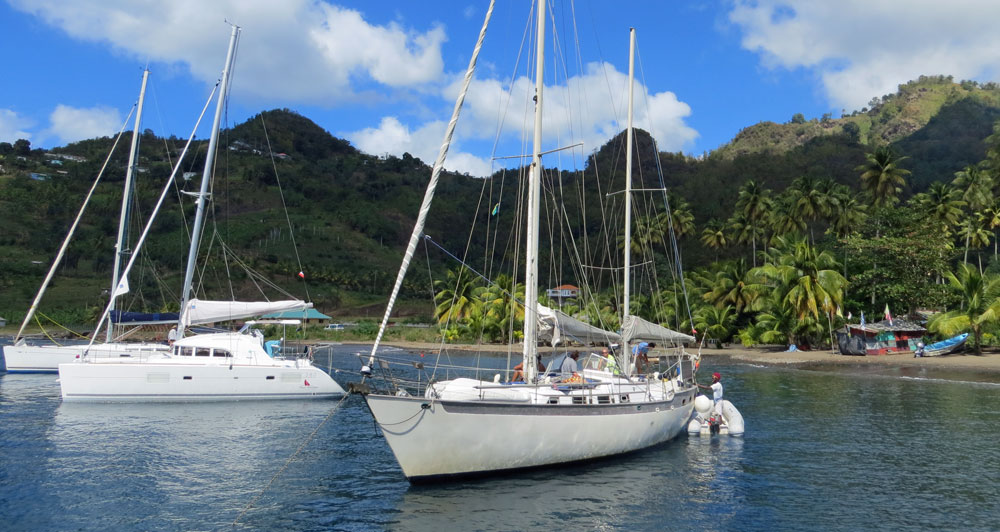 Stern-to at Cumberland Bay, St Vincent
Stern-to at Cumberland Bay, St VincentThe next anchorage is Wallilabou, famous for being a location in the film 'Pirates of the Caribbean'. Stern-to anchoring with a line ashore is also the way to go here.
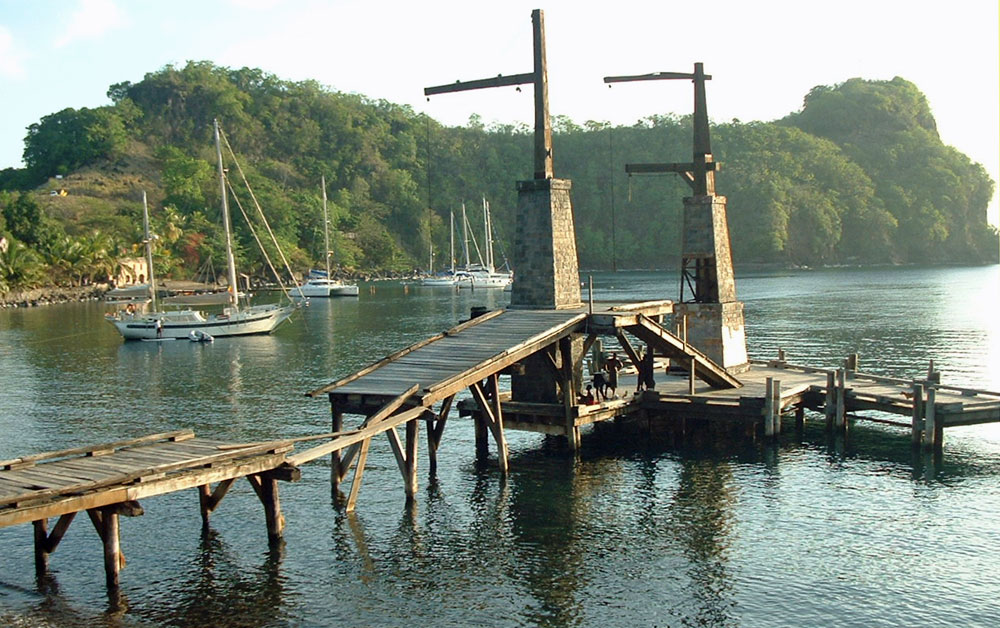 Wallilabou anchorage, with relics of the filmset from 'Pirates of the Caribbean' in the foreground
Wallilabou anchorage, with relics of the filmset from 'Pirates of the Caribbean' in the foregroundJust around the headland you'll find Keartons Bay, where you'll find a few moorings owned by the Rock Side Cafe ashore, where diners can tie up overnight for free.
There are several lesser-known anchorages between here and Young Island Cut, including:
- Barrouallie, just south of the conspicuous Bottle & Glass Rocks;
- Buccament Bay;
- Petit Byahaut;
Anchoring in Young Island Cut is not easy, but moorings are available.
At the southern end of St Vincent is Blue Lagoon, a protected comfortable anchorage but with a narrow draft-limited entrance.
We've run out of anchorages on St Vincent; it's time to head south for the delightful Grenadines.
The Grenadines
Bequia
It's just a 10-mile sail south from St Vincent to Bequia, the northernmost island in the Grenadines.
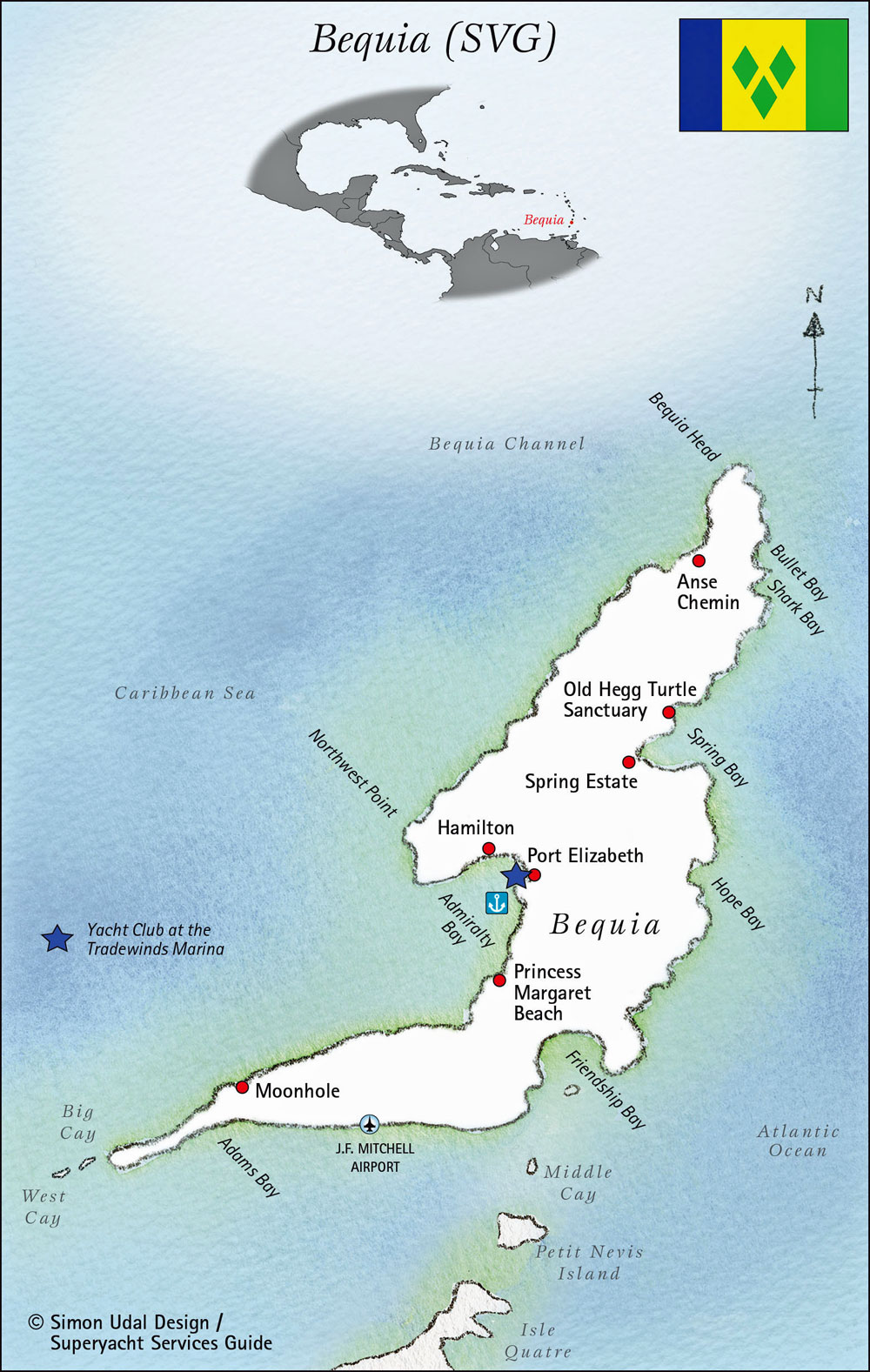
Currency: Eastern Caribbean Dollars (EC$)
Official Language: English
Ports of Entry: Bequia, Mustique, Canouan and Union Island
Provided you checked-in with Customs & Immigration in St Vincent, you don't have to do it again as Bequia and the other 31 islands that make up St Vincent & the Grenadines are all part of an inclusive island country.
Bequia is a popular place with cruisers, but you can always find a spot to anchor in Admiralty Bay, but make sure to keep out of the way of the ferries that dock in Port Elizabeth.
Ashore, you'll have plenty of shops, markets, bars and restaurants to choose from - it's a lively place, Bequia!
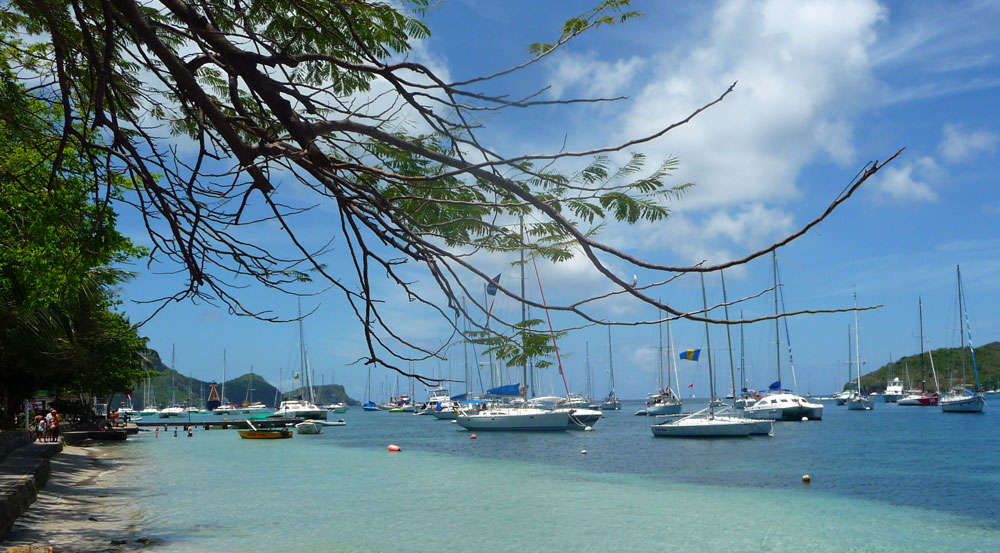 Admiralty Bay, Bequia
Admiralty Bay, BequiaWhen northerly swells make Admiralty Bay uncomfortable, you'll find Friendship Bay at the eastern end of the south coast less rolly.
When you're ready to tear yourself away from the delights of Bequia, you may want to mingle with the rich and famous on Mustique - and you should, even if it's just the once...
Mustique
Unique among the Grenadines, Mustique is a privately owned development of holiday homes - read mansions - for the extremely well-heeled.
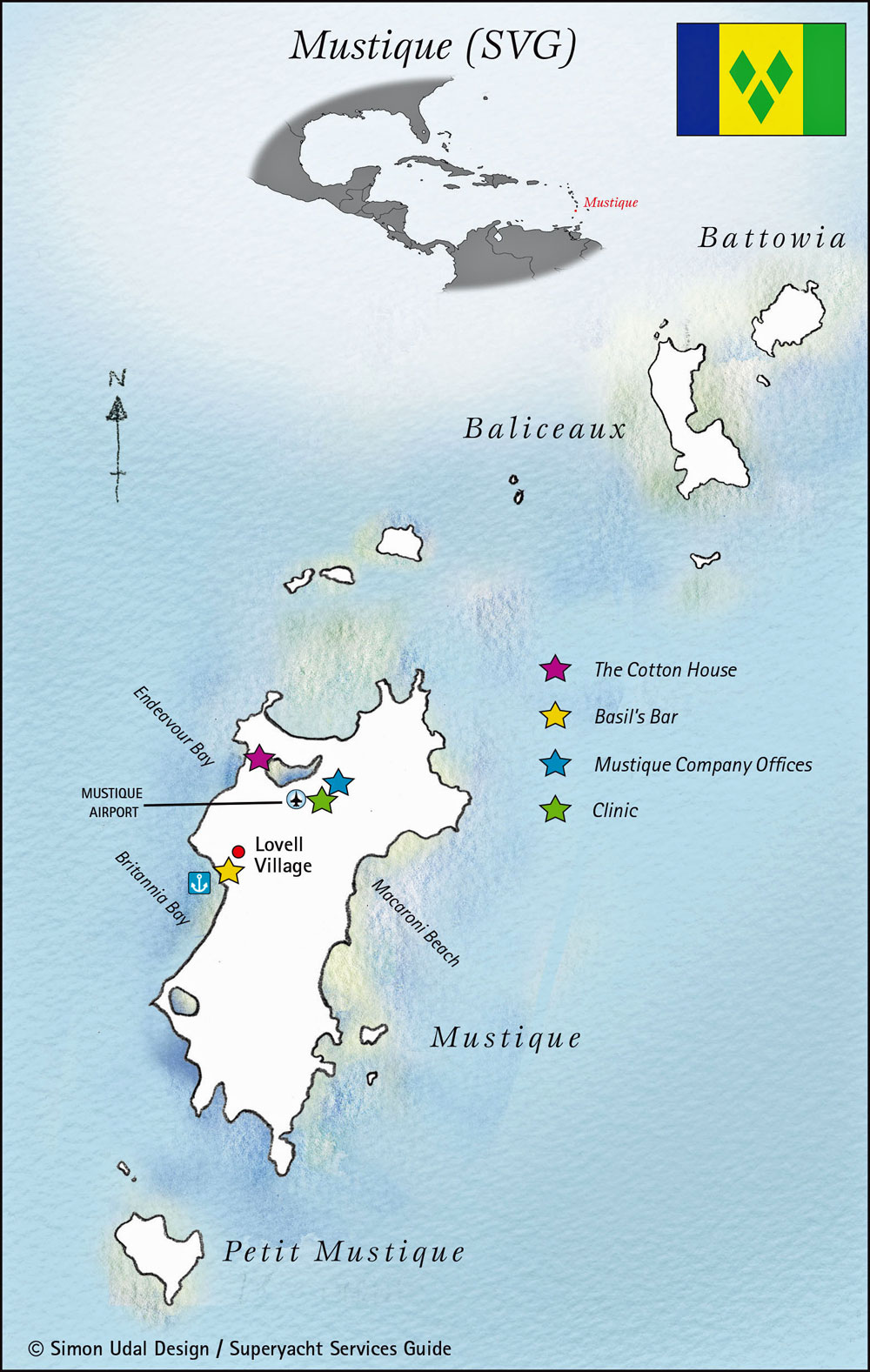
Currency: Eastern Caribbean Dollars (EC$)
Official Language: English
Ports of Entry: Bequia, Mustique, Canouan and Union Island
There's only one anchorage - Britannia Bay - and you won't be allowed to anchor if there's a mooring available.
The anchorage has a deserved reputation for being a tad rolly and uncomfortable.
Some cruiser friends of ours were having a beer in the famous Basil's Bar when Mick Jagger turned up for a jammin' session with some of his pals.
Sadly, we arrived the day after...
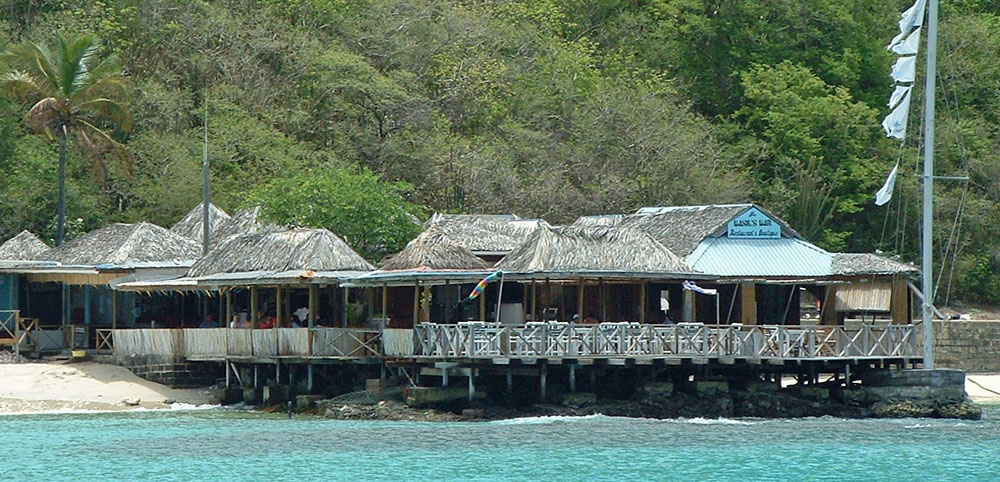 Basils's Bar, Mustique
Basils's Bar, MustiqueYou next island destination, Canouan, is just a 13M off-the-wind romp away...
Canouan
Following the opening of the Jetport and the full-service Glossy Bay Marina, the once sleepy island of Canouan has recently been described as 'the place where billionaires go to escape millionaires'.
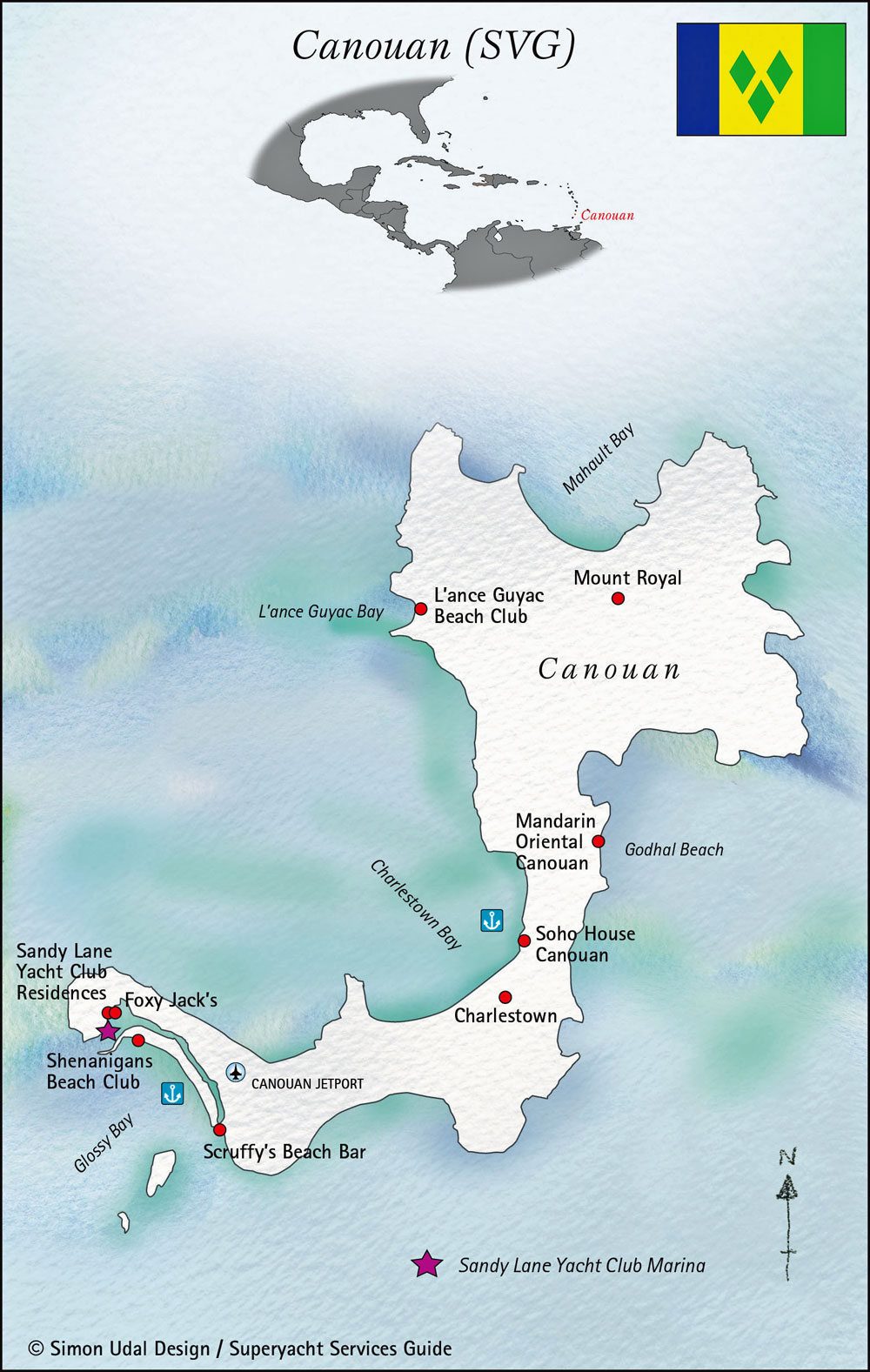
Currency: Eastern Caribbean Dollars (EC$)
Official Language: English
Ports of Entry: Bequia, Mustique, Canouan and Union Island
Fortunately, the rest of us can sneak in unnoticed on our regular sailboats.
Sneaking in from the north, there's a sheltered anchorage for a few yachts in L'ance Guyac Bay. If there's no space there, Rameau Bay is a pleasant spot.
Otherwise, drop your hook in Charlestown Bay from where you can drag your dinghy up the beach and wander into Charlestown.
Charleston Bay can be rolly in north-easterly swells but you can find some protection in Friendship Bay, which is to the east of Glossy Bay.
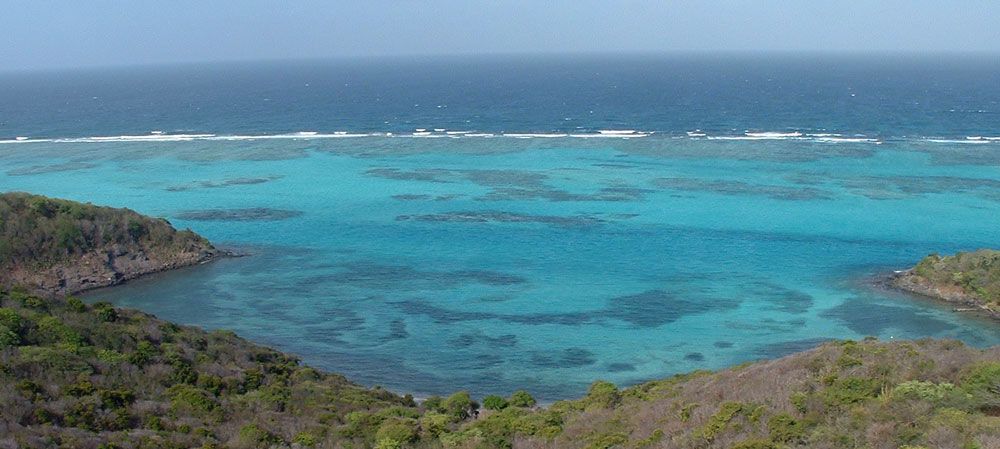 Windward reefs on the eastern side of Canouan
Windward reefs on the eastern side of CanouanIn Friendship Bay the reef which extends to the south of Friendship Point provides the protection, but you'd be well advised not to attempt to find a way into the lagoon behind the reef on the east of the island. Several have, and have come to grief.
With the heady delights of Mustique and Canouan left well astern, the Southern Grenadines await you. Now it's time to really chill-out in Mayreau, the Tobago Cays and Union Island...
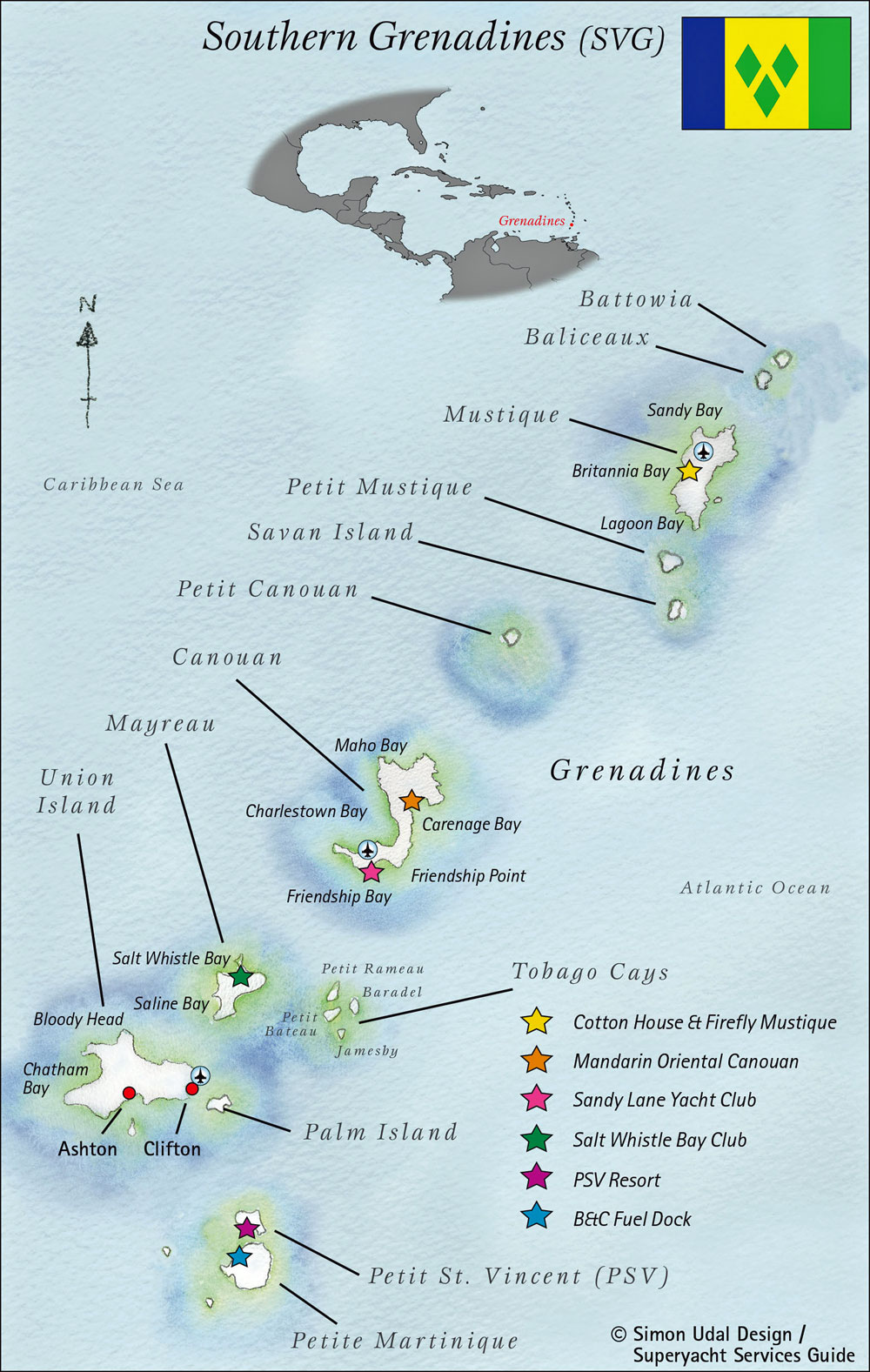
Mayreau
The waters around Mayreau are part of the Tobago Cays Marine Park, so you're not allowed to catch your dinner from your anchored boat. Not much of an issue though, as there are several local restaurants ashore just waiting to serve you with great fish and lobster dishes.
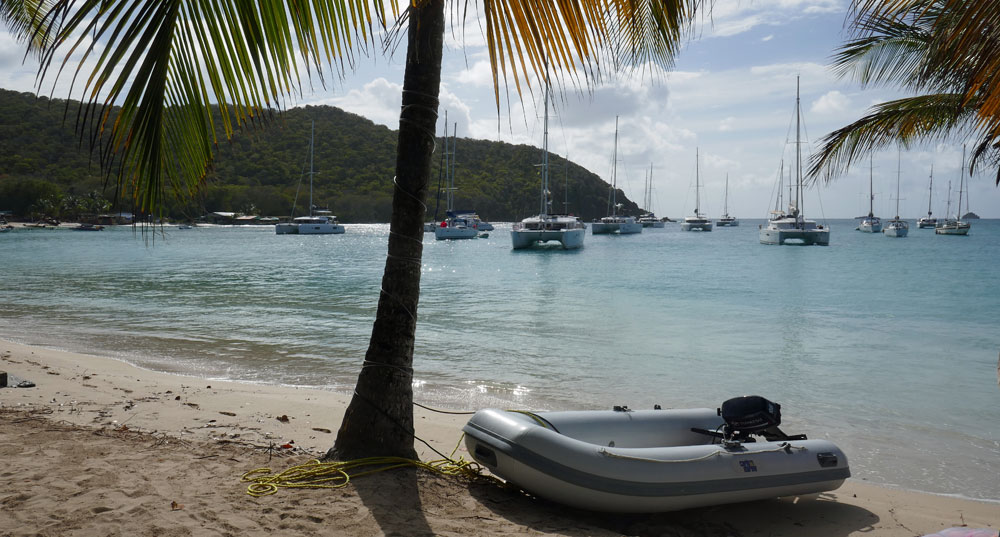 Saltwhistle Bay, Mayreau
Saltwhistle Bay, MayreauArriving from the north, the first anchorage you'll come across will be Saltwhistle Bay. It's a very popular anchorage and is often pretty crowded, so be prepared to carry on to Saline Bay where you should find plenty of space.
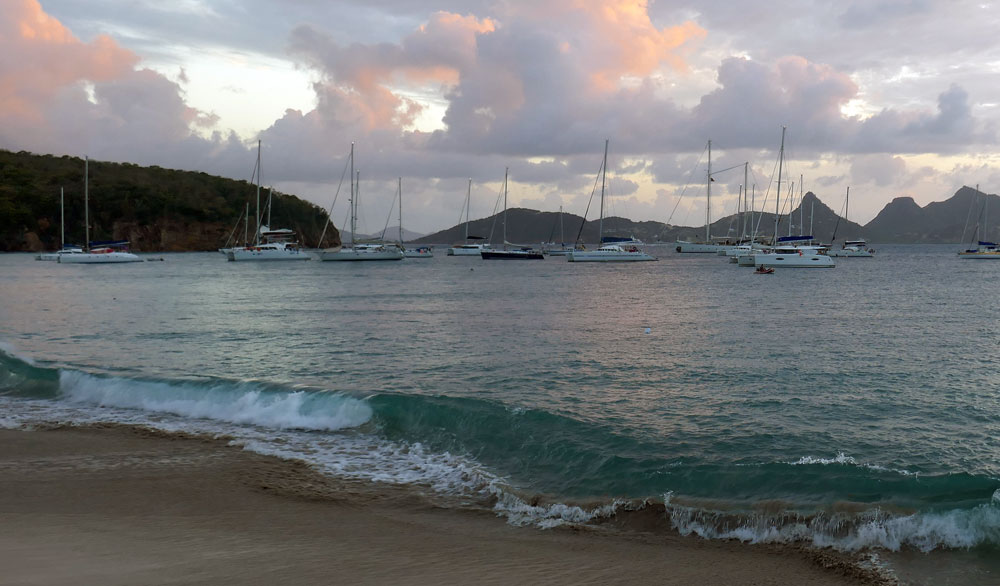 Saline Bay, Mayreau, with Union Island in the background
Saline Bay, Mayreau, with Union Island in the backgroundAt anchor in Saline Bay you can pick up a strong wifi signal from Dennis's Bar near the ferry dock - I for one, can recommend his rum punch...
If you're feeling mildly energetic, take the track near the salt pond and, leaving the pond to your right, continue to the east side of the island for an anti-clockwise circumnavigation of Mayreau on foot.
In northerly swells you can find good shelter on the windward side of the island at Upper Bay inside the reef.
Tobago Cays
Tobago Cays is made up of four uninhabited islands - Petit Rameau, Petit Bateau, Baradel and Jamesby which are enclosed by a Horseshoe Reef. A further island, Petit Tabac, is outside the reef.
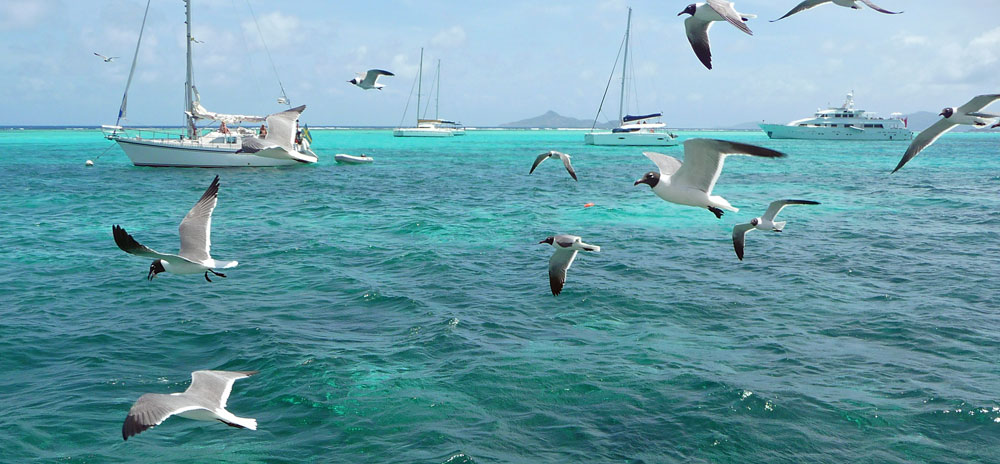 Tobago Cays - pristine and exquisite!
Tobago Cays - pristine and exquisite!This whole area is a National Park. It's pristine and exquisite - turtles, rays and other marine life clearly visible below the boat, seabirds above it and iguanas ashore. Don't miss it!
When it's time to continue south to Union Island, the easiest route is to scoot back around the north of Mayreau thereby avoiding the tricky navigation through the reefs to the south of Tobago Cays.
Union Island
There's an excellent anchorage on the west side of Union Island in Chatham Bay, although the katabatic winds that roll down the mountain can come as a surprise. The most sheltered spot is in the northeast corner, which is conveniently close to the bars and restaurants ashore.
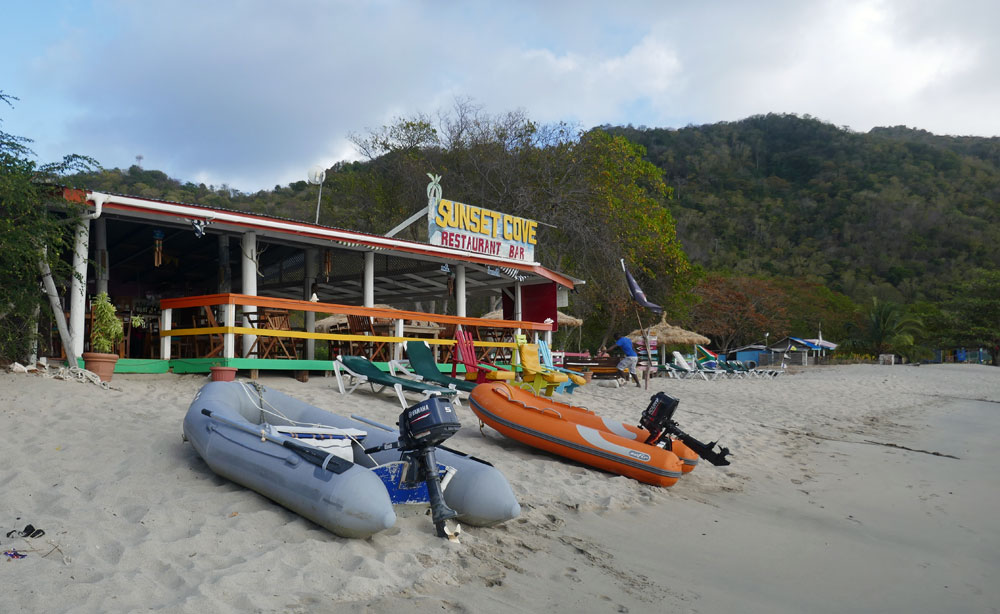 A favourite bar/restaurant for cruisers in the northeast corner of Chatham Bay, Union Island
A favourite bar/restaurant for cruisers in the northeast corner of Chatham Bay, Union IslandIt was when approaching this bar that my wife Mary came close to being knocked out of the dinghy by a pelican that wasn't looking where he was going!
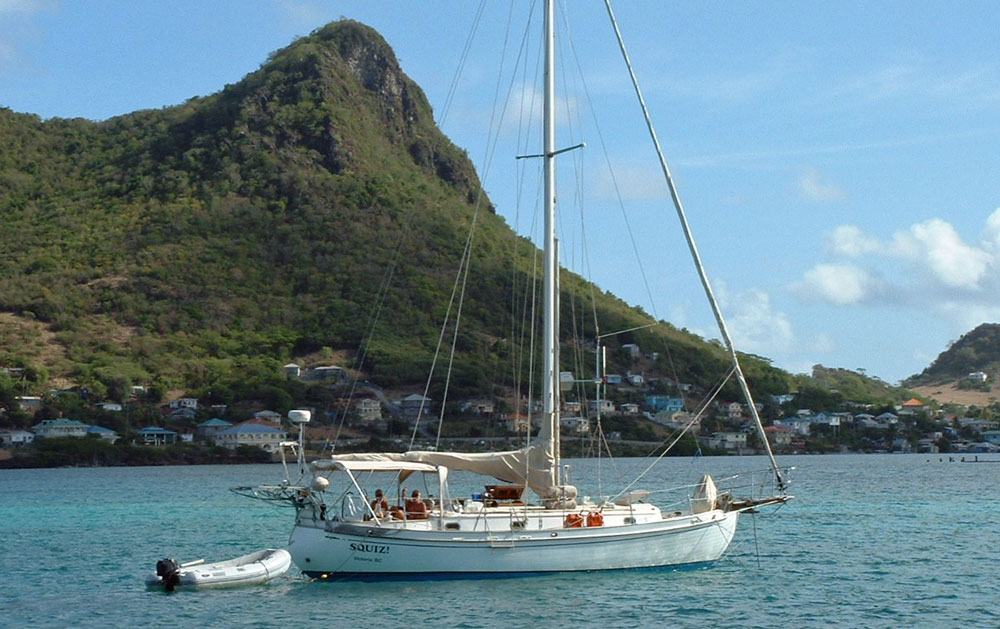 Anchored off Frigate Island, with Ashton on the far shore
Anchored off Frigate Island, with Ashton on the far shoreWhen northerly swells make Chatham Bay uncomfortable, excellent shelter can be found in the lee of Frigate Island, a short dinghy ride to the village of Ashton.
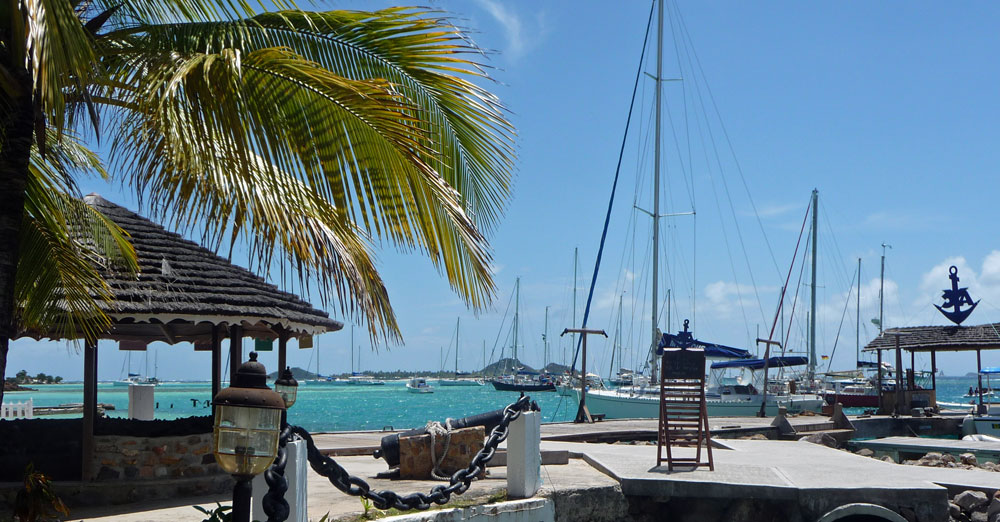 Clifton Harbour
Clifton HarbourUnion Island is the southernmost island in St Vincent & the Grenadines, and it's in Clifton you'll find the Customs & Immigration Offices from where you must check-out before continuing south to Carriacou.
Clifton Harbour is well protected by Newlands Reef. You can anchor or pick up one of the moorings if you prefer.
Carriacou
Carriacou, like Petit Martinique, 'belongs' to the main island of Grenada and is one of those islands where you must jump on one of the local buses and explore. In particular you should be sure to visit the village of Windward in Watering Bay where traditional wooden boatbuilding is still carried out.
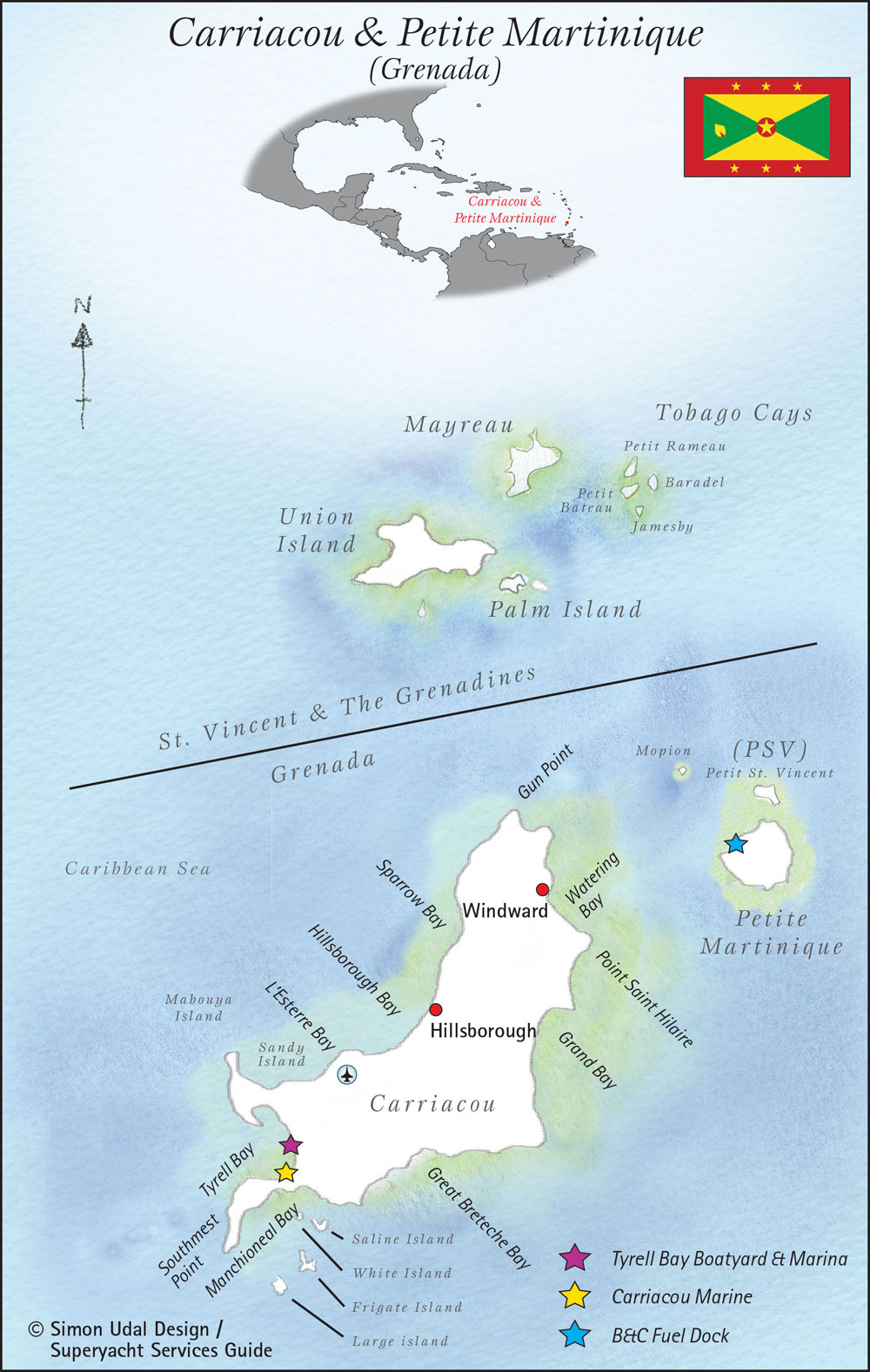
Currency: Eastern Caribbean Dollars (EC$)
Official Language: English
Port of Entry: Tyrell Bay
Hillsborough, the island's capital, is on the west coast of Carriacou, and it's here you'd previously complete the Customs, Immigration and Police formalities in two separate buildings, but not anymore.
These facilities are now located in a single building next to the Tyrrel Bay Boat yard at the southern end of the bay.
A convenient bar can found close by...
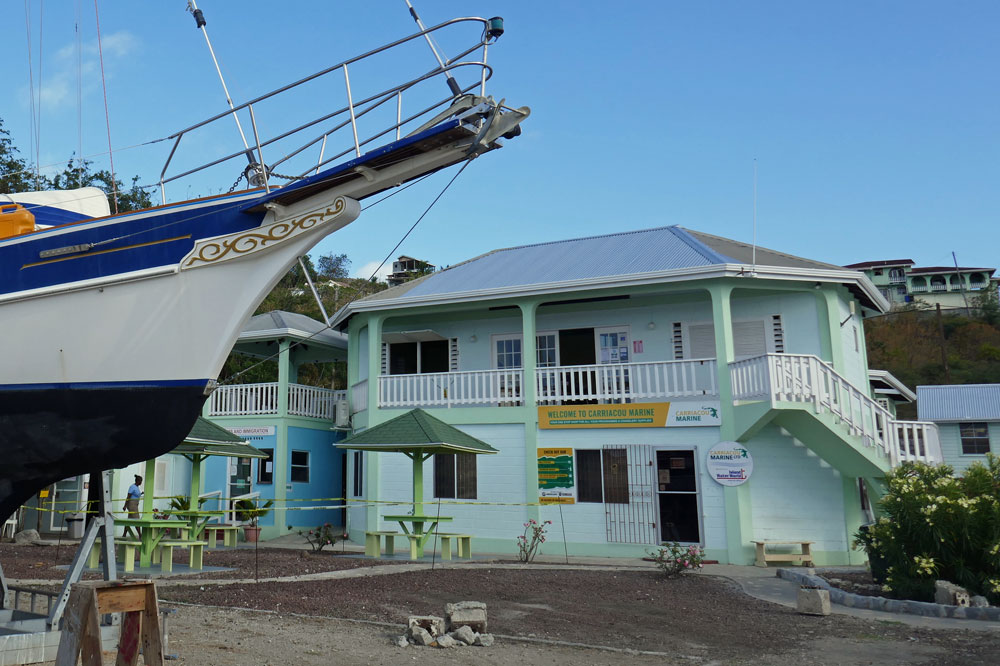 Customs & Immigration are in the building on the left
Customs & Immigration are in the building on the leftAlthough a very popular anchorage, you can always find somewhere to drop the hook in Tyrrel Bay.
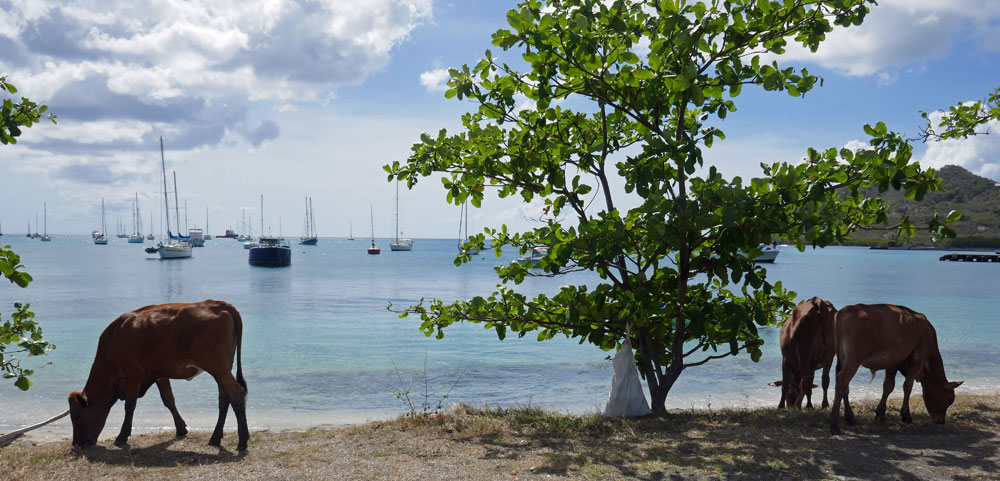
There are boatyards at each end of the bay, both with haul-out facilities and marine service workshops. There's also a well-stocked chandlery and a supermarket, plus local fruit and vegetable stalls, and bars and restaurants aplenty.
A mangrove lagoon at the north end of the bay is a well-known hurricane hole.
No wonder it's a popular place for cruisers!
Grenada
Beware, a monster lurks twixt Carriacou and Grenada. Its name is Kick'em Jenny - it's an active underwater volcano.
Depending on the magnitude of her activity you must give her a wide berth; at least 1.5km if she's quiet and 5km if she's not.
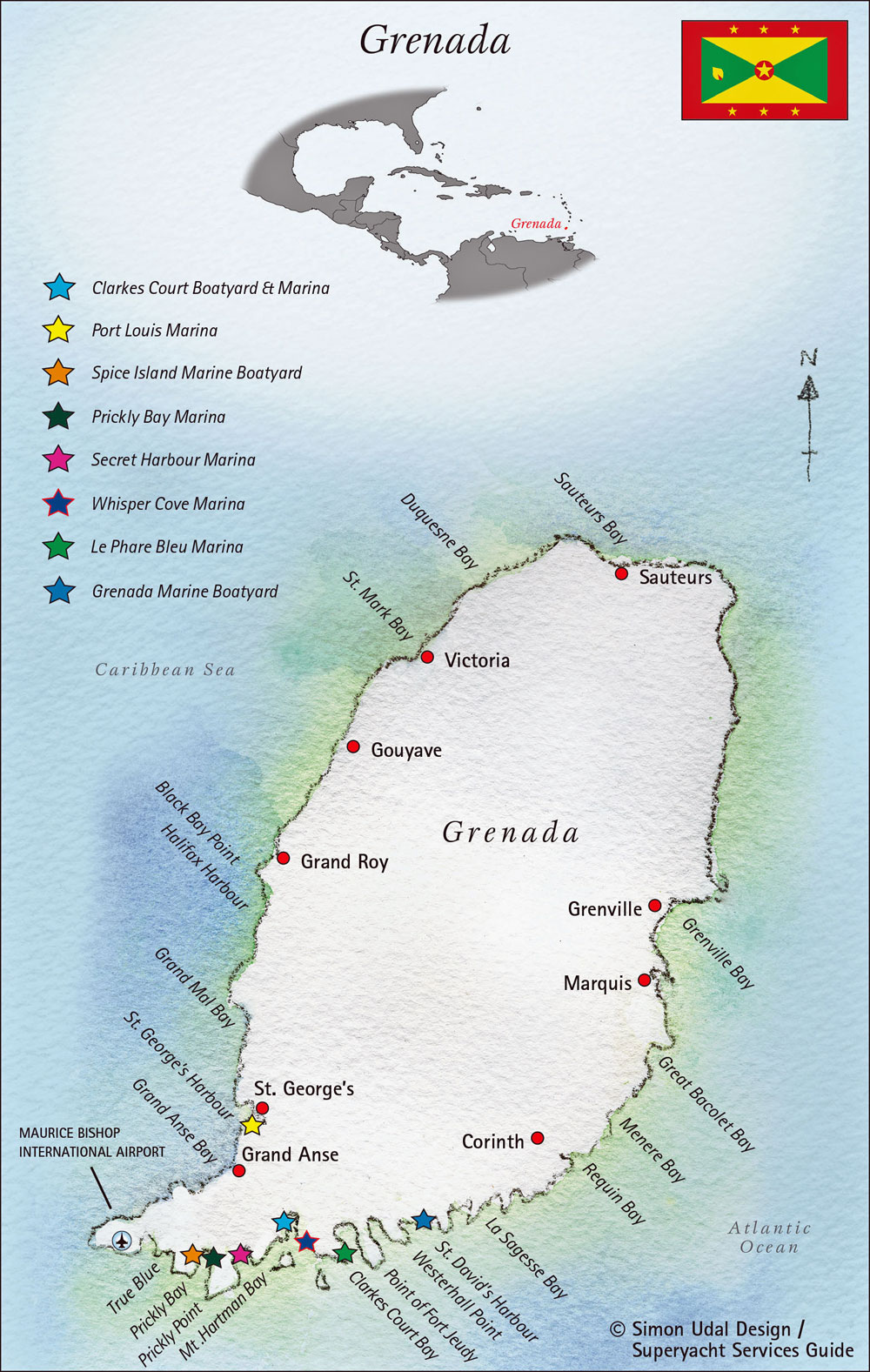
Currency: Eastern Caribbean Dollars (EC$)
Official Language: English
Port of Entry: St Georges, Prickly Bay and St Davids Harbour
Having left Kick'em Jenny safely astern, and sailing down Grenada's western shore you'll find a series of anchorages to the south of Black Bay Point - Halifax Harbour; Happy Hill; Dragon Bay; Grand Mal and to the south of St Georges Harbour.
But you may feel it's time for a few days in a full-service marina. If so, Port Louis Marina in St Georges, Grenada's capital, is the place to be.
There are a number great anchorages in the indented bays on the south coast of Grenada, one of the most popular of which is Prickly Bay.
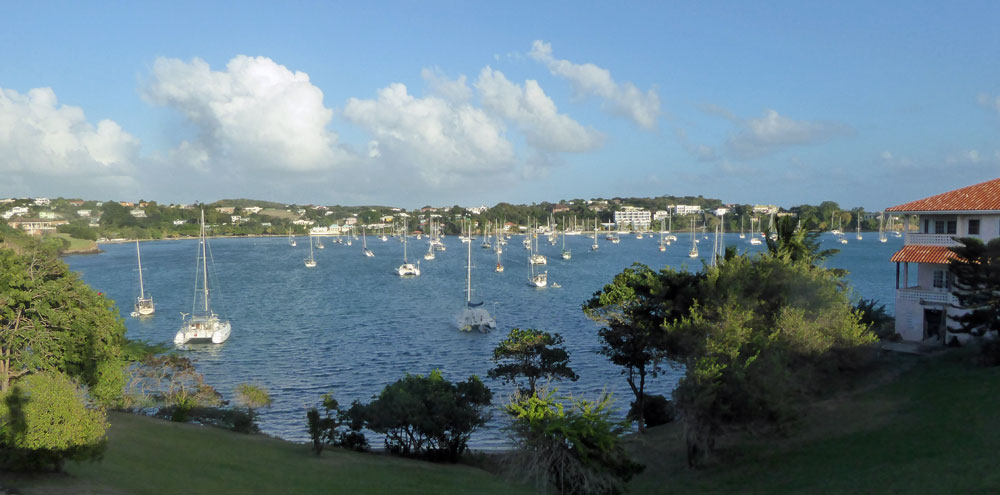 Prickly Bay, Grenada, from its western shore
Prickly Bay, Grenada, from its western shoreAt the head of Prickly Bay is Spice Island Marine, a popular boatyard with good facilities for storage ashore during the hurricane season, together with a sail loft and a well-stocked chandlery. And a bar/restaurant of course!
On the eastern side of the bay is Prickly Bay Marina where you can take on fuel and water. Here you'll also find a butcher's shop and a grocery, as well as a bar and restaurant.
Other south coast anchorages include:
- True Blue Bay - try the Dodgy Dock Bar for a memorable rum punch!
- Mount Harman Bay, with Secret Harbour Marina at its head;
- Hog Island, well-protected and a favourite with liveaboards;
- Clarkes Court Bay, with a Marina and a boatyard at its head;
- Phare Bleu Bay Marina, with an unusual restaurant venue;
- Port Egmont - a great hurricane hole!
- Calivigny Harbour;
- Westerhall Bay - best spot is in the southeast corner of the bay;
- St Davids Harbour, a well-protected anchorage with Grenada Marine Boatyard at its head.
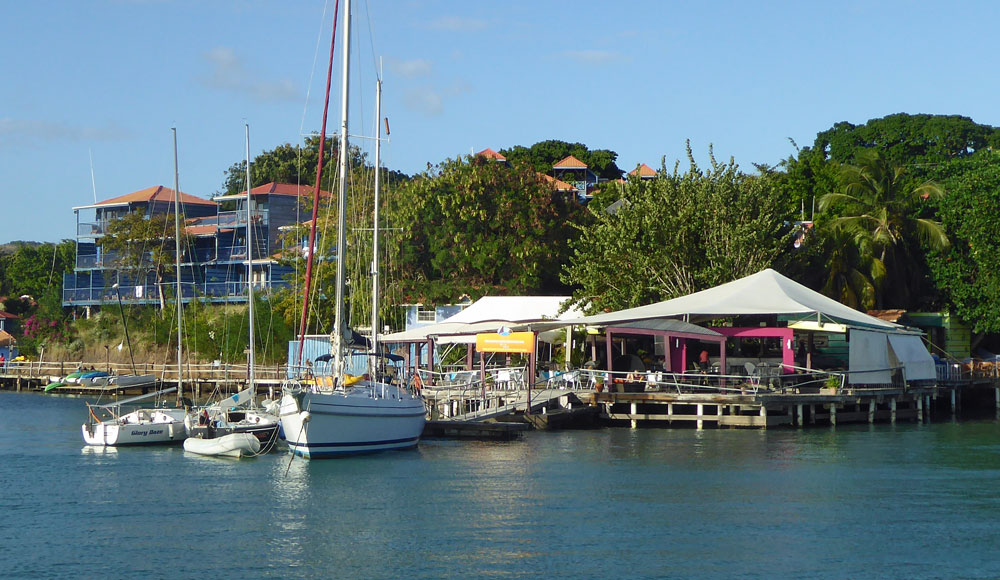 True Blue Bay, and the Dodgy Dock Bar
True Blue Bay, and the Dodgy Dock Bar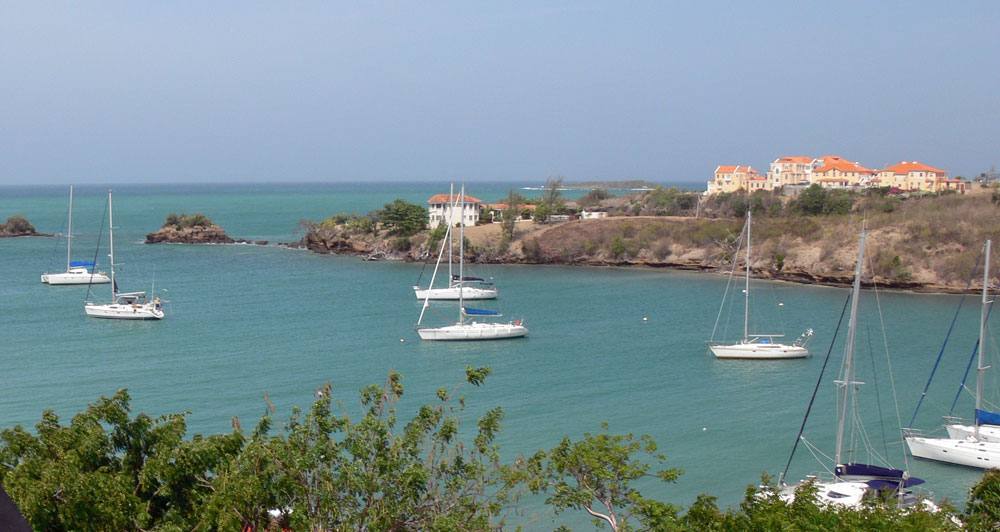 Another view of the True Blue Bay anchorage, with the University buildings in the background
Another view of the True Blue Bay anchorage, with the University buildings in the background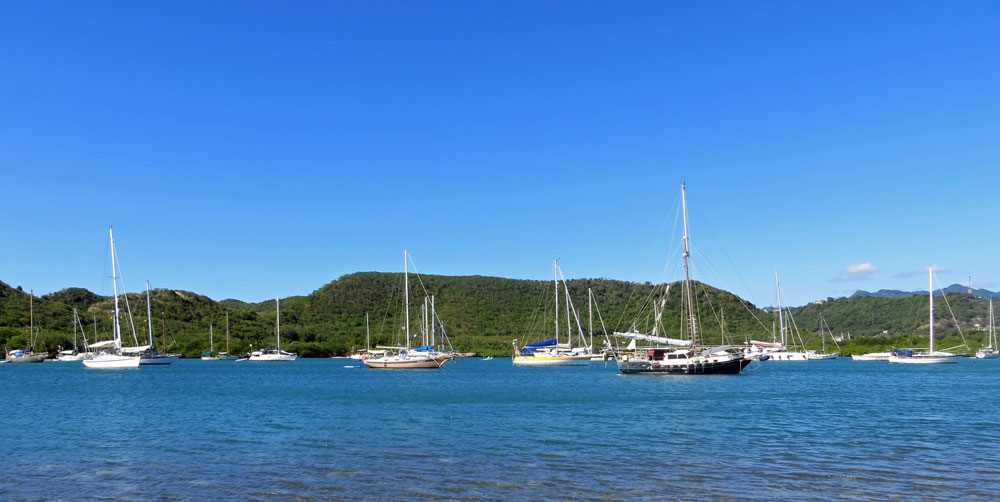 Hog Island anchorage is popular with liveaboard cruisers
Hog Island anchorage is popular with liveaboard cruisers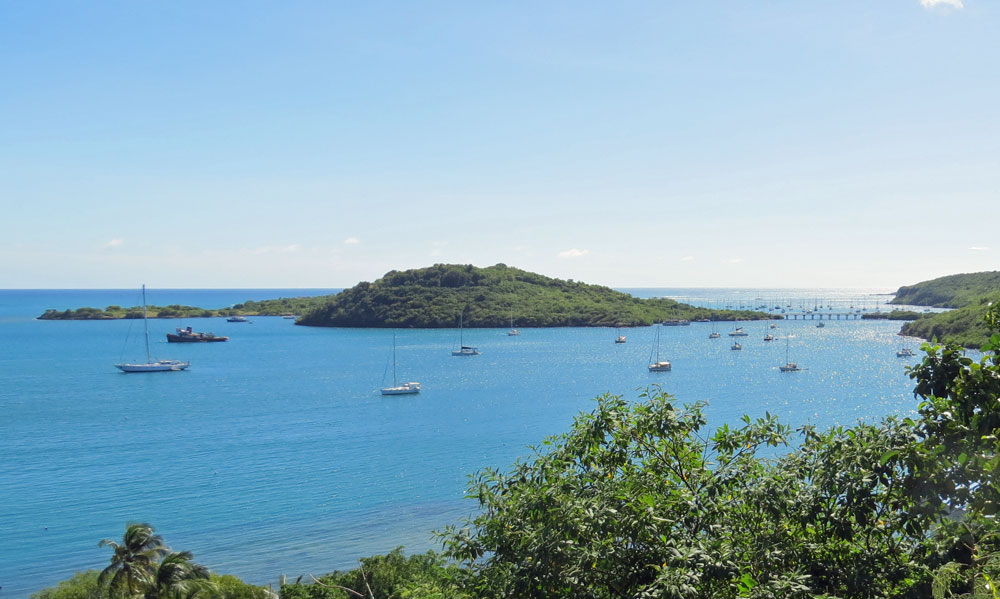 Clarkes Court Bay anchorage, with Hog Island in the background
Clarkes Court Bay anchorage, with Hog Island in the background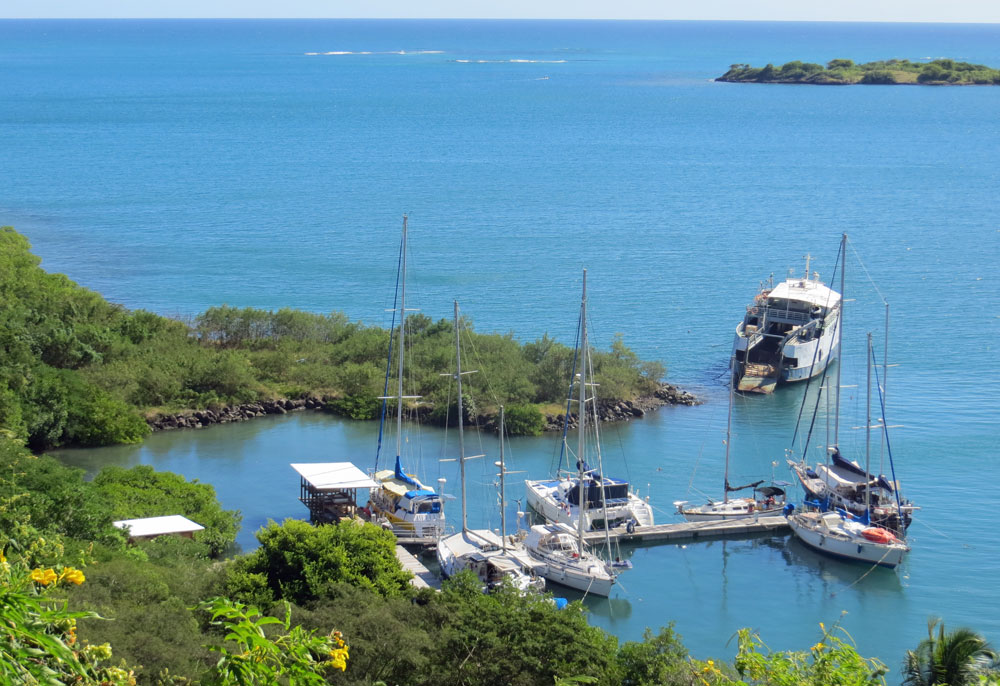 Whisper Cove Marina, in Clarkes Court Bay, Grenada
Whisper Cove Marina, in Clarkes Court Bay, Grenada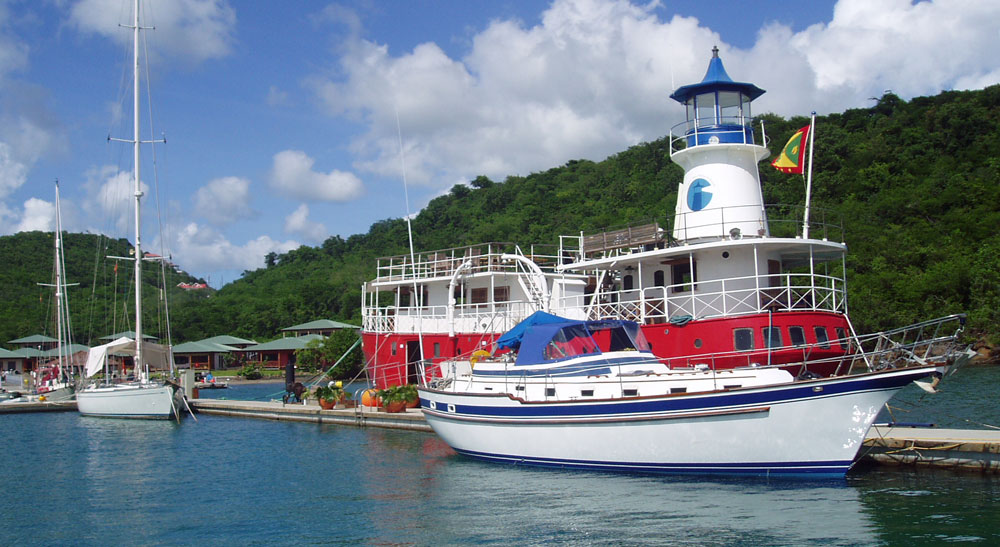 The converted Swedish Lightship 'Västra Banken' is now a popular restaurant in Phare Bleu Bay Marina
The converted Swedish Lightship 'Västra Banken' is now a popular restaurant in Phare Bleu Bay MarinaAnd that's it! Having now reached Grenada, the southernmost island in the Windward Islands, Part 2 of our Caribbean Island Hopping adventure is over. Unless, that is, you wish to turn around and repeat it from the other direction - and nobody will criticise you for that decision.
Alternatively, you could continue south to Trinidad & Tobago...
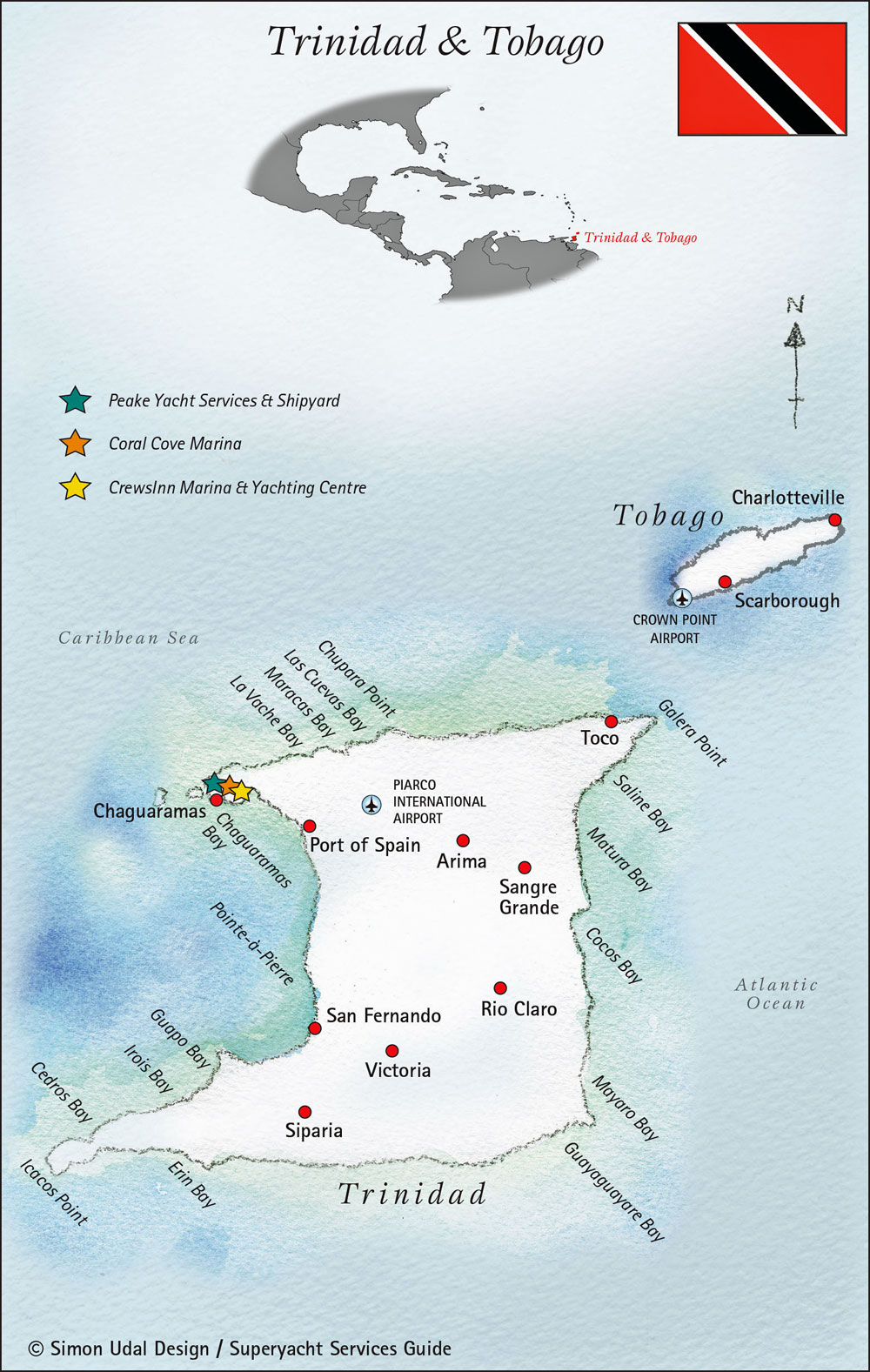
Next: Caribbean Island Hopping Part 3 - The Virgin Islands
Recent Articles
-
Albin Ballad Sailboat: Specs, Design, & Sailing Characteristics
Jul 09, 25 05:03 PM
Explore the Albin Ballad 30: detailed specs, design, sailing characteristics, and why this Swedish classic is a popular cruiser-racer. -
The Hinckley 48 Sailboat
Jul 09, 25 02:44 PM
Sailing characteristics & performance predictions, pics, specifications, dimensions and those all-important design ratios for the Hinckley 48 sailboat... -
The Hinckley Souwester 42 Sailboat
Jul 09, 25 02:05 PM
Sailing characteristics and performance predictions, pics, specifications, dimensions and those all-important design ratios for the Hinckley Souwester 42 sailboat...












